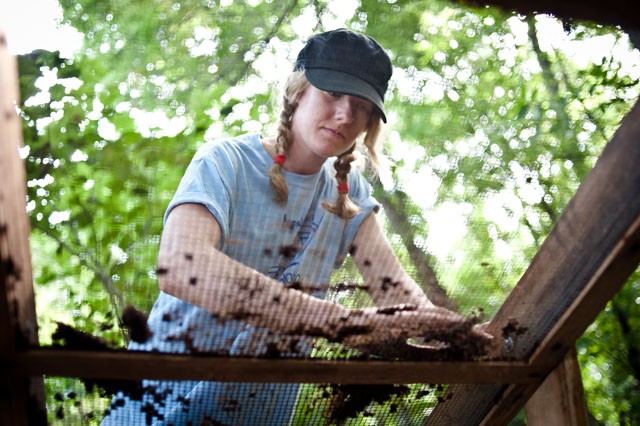Using shovels, square sifting boxes and their hands, University of Minnesota anthropology students slowly dug through the dirt on the banks of Spring Lake outside of Hastings, Minn.
Temperatures were climbing into the 90s Monday at Bremer Village, a known Native American site, and the group of 12 students and their professors had been at it for hours.
The first-time archaeologists worked through the sweltering heat in teams of two, searching for signs of a settlement that disappeared more than 800 years ago.
And then they found it.
Professor Gilliane Monnier held up the dimpled shard from the rim of a pot, unable to contain her excitement. She hadnâÄôt expected to find anything significant this early in their excavation, which began just a week ago.
Their work is part of a class offered each summer, which gives students an opportunity to learn basic excavation skills and prepare for a future in archaeology.
âÄúItâÄôs exciting because it has stylistic markings that are diagnostic of the time period,âÄù Monnier said of the pottery piece. Despite its slight damage, it was an important discovery.
The piece is an indicator that there is more for the 12 students to find as they spend the next two weeks digging through the site.
The students spend more than 30 hours a week at the site, from 8:30 a.m. to 3 p.m. each day. The class began July 11 and will run through Aug. 5.
The field work is a résumé builder and a prerequisite for any student wanting to get a job or go to graduate school in archaeology, said Ed Fleming, the Science Museum of MinnesotaâÄôs curator of archaeology, an instructor at the site.
âÄúAll of this plays into getting a job,âÄù Fleming said. âÄúThe basic principles are useful. ItâÄôs beneficial for everyone, no matter what they want to specialize in.âÄù
On Monday, students cautiously dug shovel test pits, 10 centimeters at a time. One team member digs down while the other sifts through the fresh earth, looking for signs of civilization.
About 10 yards away, another team did the same in their own pit.
âÄúThe general idea is we are trying to find a line of settlements,âÄù said Gregory Reinert, an anthropology senior.
Findings from the small test pits will help determine where to dig the larger excavation pits, which may begin later this week.
âÄúWe know there is a site, and we know the site is here, but we donâÄôt know where to dig,âÄù Fleming said.
The work students do this summer will add to the existing research on Native Americans who lived in the area.
Bremer Village was an ideal winter campsite for Native American civilizations because parts of Spring Lake never freeze, Fleming said.
So far, students have had better luck finding artifacts near the shoreline, which Fleming said he expected.
The team is looking for artifacts from three separate âÄúepisodes of occupation.âÄù
âÄúIf we can isolate those components and look at the artifacts, we can see how the cultures changed over time,âÄù Fleming said.
Three students searched the loose soil around fallen trees for anything that may have been pulled up with the tree roots.
Senior Jake Kittleson found another piece of pottery âÄî even smaller than the shard from earlier that day.
âÄúYou have all the luck,âÄù said senior Julia Ramberg as Kittleson put the earth-caked piece into a plastic bag.
Ramberg said she hopes to translate the skills from her work at Bremer Village to her focus on eastern civilizations âÄî especially Egypt.
âÄúPrehistoric archaeology gives you a lot of good basics,âÄù Ramberg said as she scoured the ground. âÄúItâÄôs a good foundation.âÄù
Kittleson signed up so he could get his hands dirty.
âÄúI just wanted the hands-on experience,âÄù Kittleson said. âÄúIâÄôm sitting in class all year and IâÄôm thinking, âÄòI want to get out there and do something.âÄôâÄù
Back at the shovel test pits, senior Ann Eoloff said she wants the class to help her gain a better perspective of how people lived in the past, but her main reason for taking the class was to try out her future career.
âÄúI mostly wanted to see if it was a good fit,âÄù Eoloff said.
A field school is offered every summer through the University. But this year, students were able to choose between two different field schools based upon their area of interest.
The students work rain or shine. On rainy days, Monnier said the students will work at the Science Museum cleaning the pieces that they find.
Fleming said he isnâÄôt worried about the weather slowing them down.
âÄúWe have the luxury of time,âÄù he said. âÄúWeâÄôre not on a contract. WeâÄôll just get as much done as we can and maybe come back next year.âÄù


